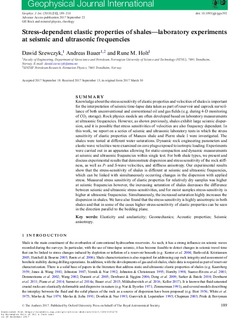| dc.contributor.author | Szewczyk, Dawid | |
| dc.contributor.author | Bauer, Andreas | |
| dc.contributor.author | Holt, Rune Martin | |
| dc.date.accessioned | 2018-03-09T11:47:38Z | |
| dc.date.available | 2018-03-09T11:47:38Z | |
| dc.date.created | 2017-11-22T09:34:46Z | |
| dc.date.issued | 2018 | |
| dc.identifier.citation | Geophysical Journal International. 2018, 212 (1), 189-210. | nb_NO |
| dc.identifier.issn | 0956-540X | |
| dc.identifier.uri | http://hdl.handle.net/11250/2489790 | |
| dc.description.abstract | Knowledge about the stress sensitivity of elastic properties and velocities of shales is important for the interpretation of seismic time-lapse data taken as part of reservoir and caprock surveillance of both unconventional and conventional oil and gas fields (e.g. during 4-D monitoring of CO2 storage). Rock physics models are often developed based on laboratory measurements at ultrasonic frequencies. However, as shown previously, shales exhibit large seismic dispersion, and it is possible that stress sensitivities of velocities are also frequency dependent. In this work, we report on a series of seismic and ultrasonic laboratory tests in which the stress sensitivity of elastic properties of Mancos shale and Pierre shale I were investigated. The shales were tested at different water saturations. Dynamic rock engineering parameters and elastic wave velocities were examined on core plugs exposed to isotropic loading. Experiments were carried out in an apparatus allowing for static-compaction and dynamic measurements at seismic and ultrasonic frequencies within single test. For both shale types, we present and discuss experimental results that demonstrate dispersion and stress sensitivity of the rock stiffness, as well as P- and S-wave velocities, and stiffness anisotropy. Our experimental results show that the stress-sensitivity of shales is different at seismic and ultrasonic frequencies, which can be linked with simultaneously occurring changes in the dispersion with applied stress. Measured stress sensitivity of elastic properties for relatively dry samples was higher at seismic frequencies however, the increasing saturation of shales decreases the difference between seismic and ultrasonic stress-sensitivities, and for moist samples stress-sensitivity is higher at ultrasonic frequencies. Simultaneously, the increased saturation highly increases the dispersion in shales. We have also found that the stress-sensitivity is highly anisotropic in both shales and that in some of the cases higher stress-sensitivity of elastic properties can be seen in the direction parallel to the bedding plane. | nb_NO |
| dc.language.iso | eng | nb_NO |
| dc.publisher | Oxford University Press | nb_NO |
| dc.title | Stress-dependent elastic properties of shales—laboratory experiments at seismic and ultrasonic frequencies | nb_NO |
| dc.type | Journal article | nb_NO |
| dc.type | Peer reviewed | nb_NO |
| dc.description.version | publishedVersion | nb_NO |
| dc.source.pagenumber | 189-210 | nb_NO |
| dc.source.volume | 212 | nb_NO |
| dc.source.journal | Geophysical Journal International | nb_NO |
| dc.source.issue | 1 | nb_NO |
| dc.identifier.doi | 10.1093/gji/ggx392 | |
| dc.identifier.cristin | 1517045 | |
| dc.relation.project | Norges forskningsråd: 234074 | nb_NO |
| dc.description.localcode | © The Authors 2017. Published by Oxford University Press on behalf of The Royal Astronomical Society. This article has been accepted for publication in Geophysical Journal International . | nb_NO |
| cristin.unitcode | 194,64,90,0 | |
| cristin.unitname | Institutt for geovitenskap og petroleum | |
| cristin.ispublished | true | |
| cristin.fulltext | original | |
| cristin.qualitycode | 2 | |
